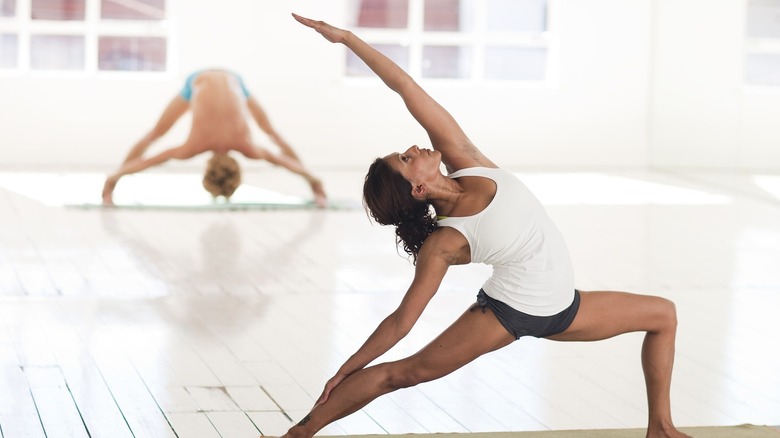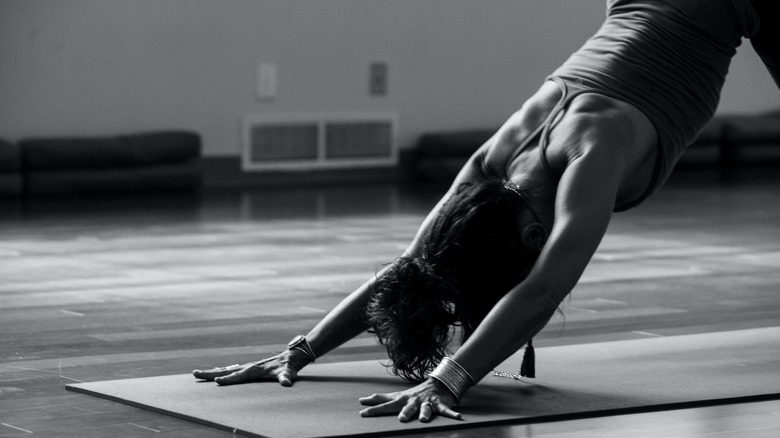Stretches That Can Help Ease IBS Pain
Irritable Bowel Syndrome, or IBS, is a gastrointestinal disorder that affects your digestive system. It leads to a number of painful symptoms, including constipation, abdominal pain, bloating, and diarrhea (via Cleveland Clinic). Needless to say, these symptoms can drastically affect your quality of life. A 2018 study conducted by Monash University found that people who suffered from IBS abdominal pain experienced trouble concentrating, vomiting, low libido, and depression. As a result, these people had to alter their lives to accommodate their symptoms. This included avoiding certain social activities, changing their travel habits, and arranging their days around the times when their IBS symptoms were the worst.
According to the International Foundation for Gastrointestinal Disorders, the dominant symptom of IBS — the pain associated with the condition — is typically described as aching, stabbing, or cramping in the abdomen. Three out of four people who have IBS report their pain as being chronic, lasting six months or longer.
Psychological stress is a major trigger for IBS, as noted in a 2014 study published in the World Journal of Gastroenterology. The anxiety that comes with stress leads to either stomach churning and subsequent diarrhea, or gas, bloating, and constipation. Managing your stress through such physical activities like yoga can be an effective way to get IBS symptoms under control (via Healthline).
Fight IBS stress with movement
Stretching can be very helpful when it comes to dealing with IBS pain (via Healthline), particularly yoga poses that target the lower abdomen. A classic bridge pose or a supine twist, in which you lie on your back and move your knees to your chest, turning them to the right and then left, can ease pressure on the abdomen. Yoga and other movement practices can induce a relaxation response and balance the autonomic nervous system (via Prevention).
According to Prevention, yoga poses like the supported child's Pose, in which rest your torso on a stack of blankets or a yoga block while on your knees, can help ease symptoms of cramping and bloating. Alternatively, lying on your back with your legs placed vertically against the wall can work to alleviate IBS-related diarrhea. Forward-folding movements can compress the abdomen, aiding in mobility and potentially relieving constipation.
Tackle IBS by getting physical
In general, if you suffer from IBS, adding physical activity to your daily routine can only be a good thing. A 2018 study published in Cytokine found that low-to-moderate aerobic activity led to a reduction in the symptoms of IBS. Similarly, another 2018 study of Iranian adults published in PLOS One showed that people who were less active were more likely to experience IBS symptoms than people who were active.
In between stretches, your posture throughout the day can also have a positive impact on IBS pain (via Healthmatch). Having an office chair that properly supports your back, standing up while working throughout the day, and adjusting your car seat so you don't have to stretch to reach the pedals are all good places to start. At night, try to sleep on your back or your left side. This puts your gut in a better position to digest, and avoid sleeping on your stomach, which compresses your organs.
If the pain becomes too much to manage, the International Foundation for Gastrointestinal Disorders notes that the symptoms can be managed with over-the-counter or prescription medications. Psychological approaches, such as relaxation therapy, meditation, and cognitive behavioral therapy, can also help. You should always consult your doctor about your IBS pain. Together, you can come up with a treatment plan that works best for you and your lifestyle. If you can get active and add some stretching to your day, you may see the benefits sooner.



